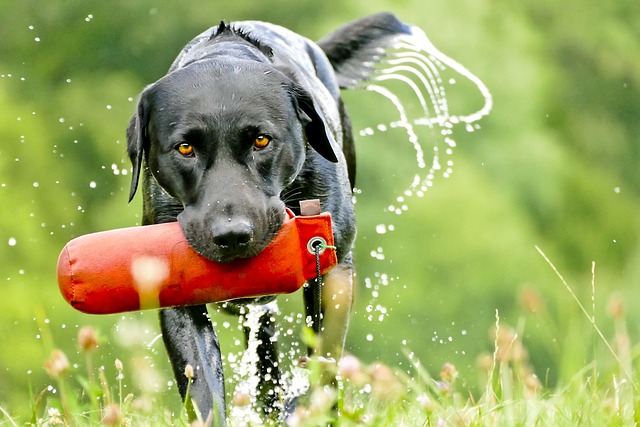When the soft little paw pads step on your palm, the wet nose rubs against your cheek, and those clear eyes are filled with unconditional trust, every dog owner desires to establish a tacit and orderly rhythm of life with their furry companions. Making a dog obedient and compliant does not mean suppressing its nature. Instead, based on respect and understanding, through scientific training methods, a communication bridge of mutual trust can be established, enabling the dog to live happily and safely within the rules of human society.
Understanding a dog's behavioral language is a prerequisite for training. Every bark, wagging tail, and pawing at the ground is a way for the dog to try to communicate with humans. For example, when a dog feels uneasy, it will frequently lick its lips, yawn, and its ears will be pressed back tightly against its head. When it is excited, it will wag its tail rapidly, and its eyes will be bright and full of anticipation. By observing and learning these behavioral languages, the owner can more accurately grasp the dog's emotional state and adjust the training strategy in a timely manner during the training process. Just as a child needs to be listened to, a dog also needs its owner to understand its "inner voice". Only in this way can the training proceed in a harmonious atmosphere.
Positive reinforcement is the most effective method for training dogs. A dog's world is simple and pure, and they long for their owner's approval and rewards. When a dog accurately executes commands such as "sit" or "shake hands", immediately give it delicious treats, enthusiastic praise, or gentle strokes to establish a strong connection between the behavior and the reward. This positive feedback will make the dog understand that performing the right behavior will lead to pleasant results, so it will take the initiative to repeat these behaviors. Different from punitive training, positive reinforcement will not make the dog feel fearful or resistant. Instead, it will deepen their trust and dependence on the owner. There was once a stray dog that was timid and cowardly due to long-term punishment. Under the new owner's consistent positive reinforcement training, it gradually became confident and cheerful. Not only did it learn multiple skills, but it also became a popular "little star" in the community.
 Establishing clear and consistent rules is crucial. A dog needs to clearly know what behaviors are allowed and what are not acceptable. Whether at home or outdoors, the owner should maintain the consistency of the rules. For example, if a dog is not allowed on the sofa, every time it tries to jump up, use a firm but gentle tone to stop it and guide it to the designated resting area. Family members should also have a unified standard to avoid confusing the dog due to inconsistent rules. This clear sense of boundaries can give the dog clear behavioral guidelines in life, thereby reducing the occurrence of bad behaviors.
Establishing clear and consistent rules is crucial. A dog needs to clearly know what behaviors are allowed and what are not acceptable. Whether at home or outdoors, the owner should maintain the consistency of the rules. For example, if a dog is not allowed on the sofa, every time it tries to jump up, use a firm but gentle tone to stop it and guide it to the designated resting area. Family members should also have a unified standard to avoid confusing the dog due to inconsistent rules. This clear sense of boundaries can give the dog clear behavioral guidelines in life, thereby reducing the occurrence of bad behaviors.
Training is a gradual process that requires the owner to have sufficient patience. Every dog has its own learning pace. Some may quickly master new skills, while others may need more time and repeated practice. Just like teaching a child to walk, one should not lose patience due to momentary setbacks. When a dog responds slowly to commands or makes mistakes, the owner should control their emotions and avoid shouting or punishing. The training content can be broken down into small steps, and the dog can be gradually guided to complete them. For example, when training the "lie down" action, first let the dog learn to "sit", then guide its front paws to stretch forward, slowly lower its body, and finally complete the lying down action. In this way, the dog can gradually master the skills in a relaxed and pleasant atmosphere.
Daily interaction is an important way to consolidate the training results. Training should not be limited to specific times and places but should be integrated into every bit of daily life. When feeding, let the dog learn to wait first and then eat after hearing the command. When going for a walk outdoors, train the dog to walk alongside you and avoid pulling on the leash. Through these daily interactions, the dog can transform the learned skills into habits. At the same time, the emotional communication between the owner and the dog during the interaction can further deepen their mutual tacit understanding. For example, the owner and the dog conduct a simple skill review every night. This can not only strengthen the dog's memory but also make the dog feel the owner's attention and companionship. This emotional satisfaction is equally important for the dog's mental health.
Social training is also a key link in making a dog obedient and compliant. Dogs are social animals, and good social skills can enable them to behave more appropriately when getting along with other dogs and humans. Exposing a dog to different people and animals from an early age and helping it adapt to various environments and sounds can effectively reduce its fear and aggression. During the social process, the owner should guide the dog to learn the correct ways of behaving, such as greeting friendly and avoiding being overly excited or jumping on people. Through social training, the dog can not only become more cheerful and confident but also better integrate into human society and become a beloved "well-behaved baby".
Training a dog to be an obedient companion is a journey full of love and wisdom. It requires the owner to be guided by professional knowledge and connected by warm emotions. In the daily interaction day after day, the owner should patiently guide and accompany the dog. When the once naughty little guy can accurately respond to the owner's commands and cooperate tacitly with the owner, the sense of accomplishment and happiness is indescribable. And the dog will also feel the owner's love and care during the training process, establish a deep trust in the owner, and create a wonderful life memory together with the owner.

 Establishing clear and consistent rules is crucial. A dog needs to clearly know what behaviors are allowed and what are not acceptable. Whether at home or outdoors, the owner should maintain the consistency of the rules. For example, if a dog is not allowed on the sofa, every time it tries to jump up, use a firm but gentle tone to stop it and guide it to the designated resting area. Family members should also have a unified standard to avoid confusing the dog due to inconsistent rules. This clear sense of boundaries can give the dog clear behavioral guidelines in life, thereby reducing the occurrence of bad behaviors.
Establishing clear and consistent rules is crucial. A dog needs to clearly know what behaviors are allowed and what are not acceptable. Whether at home or outdoors, the owner should maintain the consistency of the rules. For example, if a dog is not allowed on the sofa, every time it tries to jump up, use a firm but gentle tone to stop it and guide it to the designated resting area. Family members should also have a unified standard to avoid confusing the dog due to inconsistent rules. This clear sense of boundaries can give the dog clear behavioral guidelines in life, thereby reducing the occurrence of bad behaviors.



